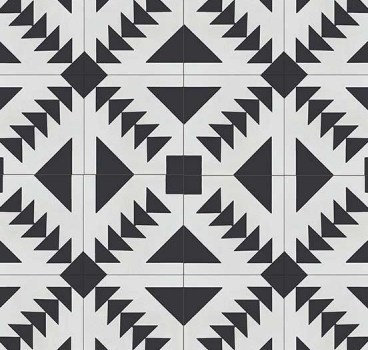Talking About Cement Tile
I'd be willing to wager that if you've surfed the world of home interiors online, your scroll has been stopped by the gorgeous, bold, stunning impact of cement tile.
( image via )
( image via )
Cement tile was first used in Catalonia, Spain in the 1800's. Each tile is made by hand using a tried and true method to produce unique, bold, intricately designed tiles that hold up to the test of time.
The method of creating each tile is truly fascinating to watch. A standard 8 x 8" cement tile is thicker than your average porcelain tile - typically about 3/4" vs porcelain tile that is more like 1/4" thick. This is due to the fact that cement tile is made up of 3 different layers.
The first layer, or top layer is made up of portland white cement, powdered marble and natural colorants in rich, vibrant hues. The color mixtures are poured into a mold to create the intricate patterns visible from the surface.
( image via )
Unlike a porcelain tile, the color permeates throughout that top layer making scratches or regular wear and tear less visible. In fact, imperfections in cement tile can actually be sanded to remove and renew their surface to like new.
The second layer is a mortar made of sand and portland gray cement which acts as a support to the top layer. Finally, a layer of high quality concrete is added to the base to give the tile the thickness it needs to endure heavy loads and routine impact. Each tile is then hydraulically pressed and cured for about 3 weeks.
To think craftsman have been using this method to create these tiles for literally hundreds of years is fascinating. And to think that some of the original tiles created this way are still here functioning on a daily basis today. These tiles are as rich with history as they are with hue - an artifact we can use to bring color and pattern to any space.
When we moved to our current home, the front and back entryway tile was in a state of disrepair. The finish was worn, tiles were cracked in different areas and the color left much to be desired. Both the areas were in need of replacement so I took it as an opportunity to give cement tile a whirl. The areas were small and the investment would be minimal and hopefully updating the tile would breathe some life back into the space.
My search took me to Cement Tile Shop which is one of the leading suppliers of Cement Tile. Being a lover of classic black and white, I narrowed my search to two designs.
One being a more classic pattern (top), the other the me-out-on-a-limb selection. I stayed true to my design aesthetic and went with the classic pattern that had a romantic feel to it.
Installation was relatively straight forward. The cement tile was thicker than the previous tile which meant adjusting the subfloor so that the tile would be flush with the hardwoods.
Fast forward to today where this handmade tile lines both our front and back entries adding an instant impact to what was once a dull and lifeless area.
While the point of this post is to share with you the beauty and history of these tiles, I also want to be truthful in my review of how they've worked for us. In all honesty, I would not install them again in this context. I have tried every recommended sealer on them, but none completely prevent the tile from discoloring with normal wear and tear. Discoloration from foot traffic settles into the porous surface making wiping up snow and sludge nearly impossible. In fact, wiping anything off cement tile is tricky because of the texture of the tile - not unlike the nature of a natural stone tile.
For comparison sake, I had a few leftover tiles. Here's what a brand new one looks like on top of the installed tile.
In previous homes we've remodeled, porcelain tile has been so slick to just wipe up snow, slush and sand from - not so much the case here. On the other hand, I'll admit that porcelain tile in a mudroom can be extremely slippery whereas cement tile is not.
The other review I will give is of its feeling under foot. It really does feel like you are walking on concrete. It's a cold, hard tile that in the dead of winter, has a cold, hard feel. If I were to consider installing this in a bathroom, I would 100% recommend radiant floor heat underneath. Having the tile warm under foot would definitely give it a more luxurious feel, but it wouldn't change the texture which takes some getting used to.
Despite its shortcomings, I have no intention of eliminating cement tile from future design plans. Cement tile adds color and texture to a space unlike other materials can, use it to add a bold and unexpected element to a space. Consider the maintenance it will require and your tolerance for its natural patina over time. If you like the look without the maintenance, explore ceramic or porcelain patterned tile as well.
( image via )
( image via )
( image via)
( image via )
( image via )
( image via )
If you have suggestions of what's worked to clean cement tile or a particular sealer you've had success with, leave it in the comments below - I'd love to hear your thoughts. I've had the greatest success with using this Mr. Clean Magic Eraser Mop. It actually does wonders to brighten it up.
This post contains affiliate links



















